A Density Functional Theory Study on the Effects of Silver Doping on the Properties and Flotation Behavior of Jamesonite
Abstract
1. Introduction
2. Results and Discussion
2.1. LA-ICP-MS Micro-Area In Situ Trace Element Determination
2.2. Existence States of Silver in the Lattice of Jamesonite
2.2.1. Lattice Substitution of Ag
2.2.2. Vacancy Doping of Ag
2.3. Adsorption Behavior of Ag-Doped Jamesonite Surface
2.3.1. Jamesonite Surface Adsorption Site
2.3.2. Adsorption Structure of Collector on Jamesonite Surface
2.3.3. Density of States of Collector Adsorption on Jamesonite Surface
2.3.4. Mulliken Charge Transfer at Ag Site
2.4. Micro-Flotation Experiment Results
2.5. Coordination Chemistry Principles of Ag-Doped Jamesonite
3. Materials and Methods
3.1. LA-ICP-MS
3.2. DFT Calculation Method
3.2.1. Calculation Method
3.2.2. Calculation Model
3.2.3. Formation Energy Calculation Method
3.3. Micro-Flotation Experiment
4. Conclusions
- An LA-ICP-MS analysis determined that Ag existed in the lattice of jamesonite from Dachang. Using density functional theory, it was found that Ag existed in the form of lattice S−Sb vacancy doping in jamesonite. A Mulliken population and band structure analysis revealed that the doped Ag atoms could form strong covalent bonds with surrounding S atoms, resulting in strong interactions.
- An analysis of the adsorption structures of the three different collectors on the surface of jamesonite indicated that the doping of Ag strengthened the adsorption of collectors on the surface of jamesonite. The adsorption of the three collectors at the Pb–Ag sites was strongest, with the following order of adsorption strength: DDTC > 3418A > butyl xanthate.
- Micro-flotation experiments on jamesonite from Dachang, Guangxi, showed that all three collectors exhibited strong collecting abilities. Under different dosages, the collecting performance of the three collectors for jamesonite was in the following order: DDTC > 3418A > butyl xanthate.
- Studies on the coordination chemistry principles of Ag atom doping revealed that when Ag atoms were present in jamesonite, the d10 electron configuration of Ag+ transforms into a d9s1 configuration, leading to increased activity. Due to the large polarizability of Ag, it affects the surrounding Pb atoms, enhancing the formation of π-backbonding by collector molecules at Ag sites.
Author Contributions
Funding
Informed Consent Statement
Data Availability Statement
Conflicts of Interest
References
- Li, X.; Wang, Q. New progress in the study of jamesonite group minerals in Dachang ore field. Acta Mineral. Sin. 1986, 4, 371–374. (In Chinese) [Google Scholar]
- Xu, Y.; Hua, Y. Study on new separation technology of lead antimony from jamesonite. In China Nonferrous Metallurgy; Springer: Singapore, 2005; pp. 53–55. (In Chinese) [Google Scholar]
- Zhang, H.; Hou, Q.; Gu, Y.; Qi, M. First-principles study on the effects of different valence VZn and Ag doping with Hi co-existence on the magnetism and photocatalysis of ZnO. Vacuum 2023, 217, 112514. [Google Scholar] [CrossRef]
- Zhang, H.; Yu, H.; Sun, W.; Lin, S.; Zhang, C. Beneficiation of silver and silver-bearing lead–zinc ores: A review. Miner. Eng. 2024, 208, 108608. [Google Scholar] [CrossRef]
- Qin, Z.; Hu, Y.; Xu, J.; Chen, T. FTIR spectroscopic study of electrochemical flotation of jamesonite-diethyldithiocarbamate system. Trans. Nonferrous Met. Soc. China 2006, 16, 493–496. [Google Scholar] [CrossRef]
- Yi, Y.; Pi, D.; Jiang, A. Occurrence, source and enrichment mechanism of silver in black shale-hosted Baiguoyuan Ag-V ore deposit, Hubei Province, China. J. Geochem. Explor. 2017, 183, 79–87. [Google Scholar] [CrossRef]
- Hu, Z.; Tang, J.; Ding, F.; Zheng, W.; Deng, S.; Yang, Y.; Zhang, Z.; Wang, Y.; Lin, B.; Ding, S. Geological characteristics of the silver-enriched polymetallic deposit of the xizang jiama copper mine, and study on the silver occurrence and enrichment mechanism. Acta Geosci. Sin. 2011, 32, 668–680. (In Chinese) [Google Scholar]
- Zhou, W. Study on the silver occurrence in major associated (co-existing) silver deposits in China. Miner. Resour. Geol. 1994, 4, 233–244. (In Chinese) [Google Scholar]
- Zhou, X.; Zhao, C.; Li, Y.; Chen, J.; Chen, Y. The flotation process, smelting process and extraction products on jamesonite: A review. Miner. Eng. 2021, 172, 107146. [Google Scholar] [CrossRef]
- Kharbish, S.; Jeleň, S. Raman spectroscopy of the Pb-Sb sulfosalts minerals: Boulangerite, jamesonite, robinsonite and zinkenite. Vib. Spectrosc. 2016, 85, 157–166. [Google Scholar] [CrossRef]
- Sun, W.; Han, H.; Tao, H.; Liu, R. Study on the flotation technology and adsorption mechanism of galena–jamesonite separation. Int. J. Min. Sci. Technol. 2015, 25, 53–57. [Google Scholar] [CrossRef]
- Zhang, Z.; Deng, L.; Zhou, X. Adsorption behavior of fluorides on Ag (1 1 1) and its doped surfaces: A first-principles calculation. Chem. Eng. Sci. 2023, 280, 119071. [Google Scholar] [CrossRef]
- Azevedo, S.A.; Laranjeira, J.A.S.; Martins, N.F.; Sambrano, J.R. Ag doping effect on electronic and thermoelectric properties of SrTiO3 (0 0 1) surface. Comp. Mater. Sci. 2023, 227, 112274. [Google Scholar] [CrossRef]
- Zhao, Y.; Ding, W.; Xiao, Y.; Yang, P. First-principles study on p-type transformation of ZnO doped by Ag element. Phys. B 2023, 657, 414810. [Google Scholar] [CrossRef]
- Zhou, X.; Zhao, C.; Chen, J.; Feng, Y. The effect of composition changes on the structure and electronic properties of jamesonite: A DFT study. RSC Adv. 2023, 13, 26516–26527. [Google Scholar] [CrossRef] [PubMed]
- Costagliola, P.; Di Benedetto, F.; Benvenuti, M.; Benvenuti, M.; Piero Bernardini, G.; Cipriani, C.; Lattanzi, P.F.; Romanelli, M. Chemical speciation of Ag in galena by EPR spectroscopy. Am. Miner. 2003, 88, 1345–1350. [Google Scholar] [CrossRef]
- Jameel, M.H.; Saleem, S.; Hashim, M.; Roslan, M.S.; Somaily, H.H.N.; Hessin, M.M.; El-Bahy, Z.M.; Ashiq, M.G.B.; Hamzah, M.Q.; Jabbar, A.H.; et al. A comparative study on characterizations and synthesis of pure lead sulfide (PbS) and Ag-doped PbS for photovoltaic applications. Nanotechnol. Rev. 2021, 10, 1484–1492. [Google Scholar] [CrossRef]
- Chen, J.; Ke, B.; Lan, L.; Li, Y. DFT and experimental studies of oxygen adsorption on galena surface bearing Ag, Mn, Bi and Cu impurities. Miner. Eng. 2015, 71, 170–179. [Google Scholar] [CrossRef]
- Chen, J.; Ke, B.; Lan, L.; Li, Y. Influence of Ag, Sb, Bi and Zn impurities on electrochemical and flotation behaviour of galena. Miner. Eng. 2015, 72, 10–16. [Google Scholar] [CrossRef]
- Chen, J.; Li, Y.; Long, Q.; Wei, Z.; Chen, Y. Improving the selective flotation of jamesonite using tannin extract. Int. J. Miner. Process. 2011, 100, 54–56. [Google Scholar] [CrossRef]
- Chen, J.; Li, Y.; Long, Q. Molecular structures and activity of organic depressants for marmatite, jamesonite and pyrite flotation. Trans. Nonferrous Met. Soc. China 2010, 20, 1993–1999. [Google Scholar] [CrossRef]
- Qiu, H.; Sun, X.; Wu, B.; Chen, J.; Hu, M.; Chen, Z.; Zheng, C. Effect of DL-cysteine on the flotation behavior of jamesonite and marmatite: Experimental and DFT studies. J. Mol. Liq. 2023, 389, 122906. [Google Scholar] [CrossRef]
- Huang, H.; Sun, W. Effect of 2-aminothiophenol on the separation of jamesonite and marmatite. Min. Sci. Technol. 2010, 20, 425–427. [Google Scholar] [CrossRef]
- Zhao, C.; Chen, J.; Li, Y.; He, Q.; Wu, B. Electronic structure and flotation behavior of complex mineral jamesonite. Trans. Nonferrous Met. Soc. China 2015, 25, 590–596. [Google Scholar] [CrossRef]
- Cui, W.; Zhang, J.; Liu, Z.; Chen, J. Selective enhancement of jamesonite flotation using Aerophine 3418A/DDTC mixture. Miner. Eng. 2023, 191, 107934. [Google Scholar] [CrossRef]
- Feng, Y.; Chen, Y.; Chen, J. The mechanism of surface activation in sphalerite by metal ions with d10 electronic configurations: Experimental and DFT study. Appl. Surf. Sci. 2024, 649, 159181. [Google Scholar] [CrossRef]
- Zhang, L.; Fu, B.; Li, H. Advances in the application of inductively coupled plasma mass spectrometry. Min. Metall. 2004, 1, 101–106. (In Chinese) [Google Scholar]
- Léone, P.; André, G.; Doussier, C.; Moëlo, Y. Neutron diffraction study of the magnetic ordering of jamesonite (FePb4Sb6S14). J. Magn. Magn. Mater. 2004, 284, 92–96. [Google Scholar] [CrossRef]
- Landa-Canovas, A.R.; Otero-Diaz, L.C.; Botto, L.; Schalamuk, I.B. Electron microscopy study of the decomposition products at 1300 °C from jamesonite mineral FePb4Sb6S14. Solid State Ion. 1993, 63, 301–306. [Google Scholar] [CrossRef]
- Matsushita, Y.; Ueda, Y. Structure and physical properties of 1D magnetic chalcogenide, jamesonite (FePb4Sb6S14). Inorg. Chem. 2003, 42, 7830–7838. [Google Scholar] [CrossRef]
- Feng, Y.; Li, Z.; Chen, J.; Chen, Y. Effect of content and spin state of iron on electronic properties and floatability of iron-bearing sphalerite: A DFT+ U study. Int. J. Min. Sci. Technol. 2023, 33, 1563–1571. [Google Scholar] [CrossRef]
- Yang, X.; Zhang, C.; Jin, W.; Guo, Z.; Gao, H.; Niu, S.; Zhao, F.; Liu, B.; Ma, H. Revealing the correlation between adsorption energy and activation energy to predict the catalytic activity of metal oxides for HMX using DFT. Def. Technol. 2024, 31, 262–270. [Google Scholar] [CrossRef]
- Bahamon, D.; Khalil, M.; Belabbes, A.; Alwahedi, Y.; Vega, L.F.; Polychronopoulou, K. A DFT study of the adsorption energy and electronic interactions of the SO2 molecule on a CoP hydrotreating catalyst. RSC Adv. 2021, 11, 2947–2957. [Google Scholar] [CrossRef]
- Mozhdehi, A.M.; Bamoharram, F.F.; Morsali, A.; Sharifi, A.M.; Sharifi, S.; Ganjali, A. Comprehension of the role of created hydrogen bonds and adsorption energy in polyamide-nanosilica- Keggin hybrid/ water on enhancement of concrete compressive strength: DFT calculations and experimental investigations. J. Mol. Liq. 2020, 297, 111912. [Google Scholar] [CrossRef]
- Galán, O.A.L.; Carbajal-Franco, G. Energy profiles by DFT methods for CO and NO catalytic adsorption over ZnO surfaces. Catal. Today 2021, 360, 28–45. [Google Scholar] [CrossRef]
- Wang, W.; Zhao, X.; Bai, X.; Ma, X.; Lin, W.; Yu, J. Investigation of factors affecting oil-water separation efficiency in micro-bubble micro-cyclonic flow air flotation. J. Water. Process. Eng. 2024, 67, 106094. [Google Scholar] [CrossRef]
- Zeng, M.; Li, K.; Huang, L.; Bao, S.; Liu, C.; Yang, S. Interaction mechanism of interfacial nano-micro bubbles with collectors and its effects on the fine apatite flotation. Appl. Surf. Sci. 2024, 682, 161736. [Google Scholar] [CrossRef]
- Xie, Z.; Zhang, L.; Liu, S. Investigation on the flotation of a mixed collector and its mechanism for enhancing low-rank coal flotation: Effect of micro adsorption and its interaction with gangue particle. Miner. Eng. 2024, 217, 108945. [Google Scholar] [CrossRef]
- Xie, J.; Liu, L.; Huo, X.; Liu, Q.; Liu, X.; Duan, R. Effect of micro-bubble size and dynamic characteristics on oil removal efficiency of the flotation. Sep. Purif. Technol. 2024, 337, 126421. [Google Scholar] [CrossRef]
- Wang, L.; Wang, M.; Li, M.; Su, J.; Ni, Z.; Gui, X. A novel approach to the separation of macerals in inertinite-rich coal: Charged micro-nanobubble flotation. Colloids Surf. A 2024, 699, 134707. [Google Scholar] [CrossRef]
- Luo, A.; Chen, J.; Zhang, Y.; Chen, H.; Liu, Z. Experimental and mechanistic study of selenium-based organic compounds as new collectors for copper ore flotation. Appl. Surf. Sci. 2025, 696, 162971. [Google Scholar] [CrossRef]
- Feng, Y.; Chen, Y.; Chen, K.; Yi, C.; Nong, Y.; Chen, Z. Adsorption of Polycarboxylate Ether Superplasticizer Incorporating Various Functional Groups on the Kaolin (001) Surface: Theoretical Study and Experimental Testing. MetaResource 2024, 1, 61–73. [Google Scholar] [CrossRef]
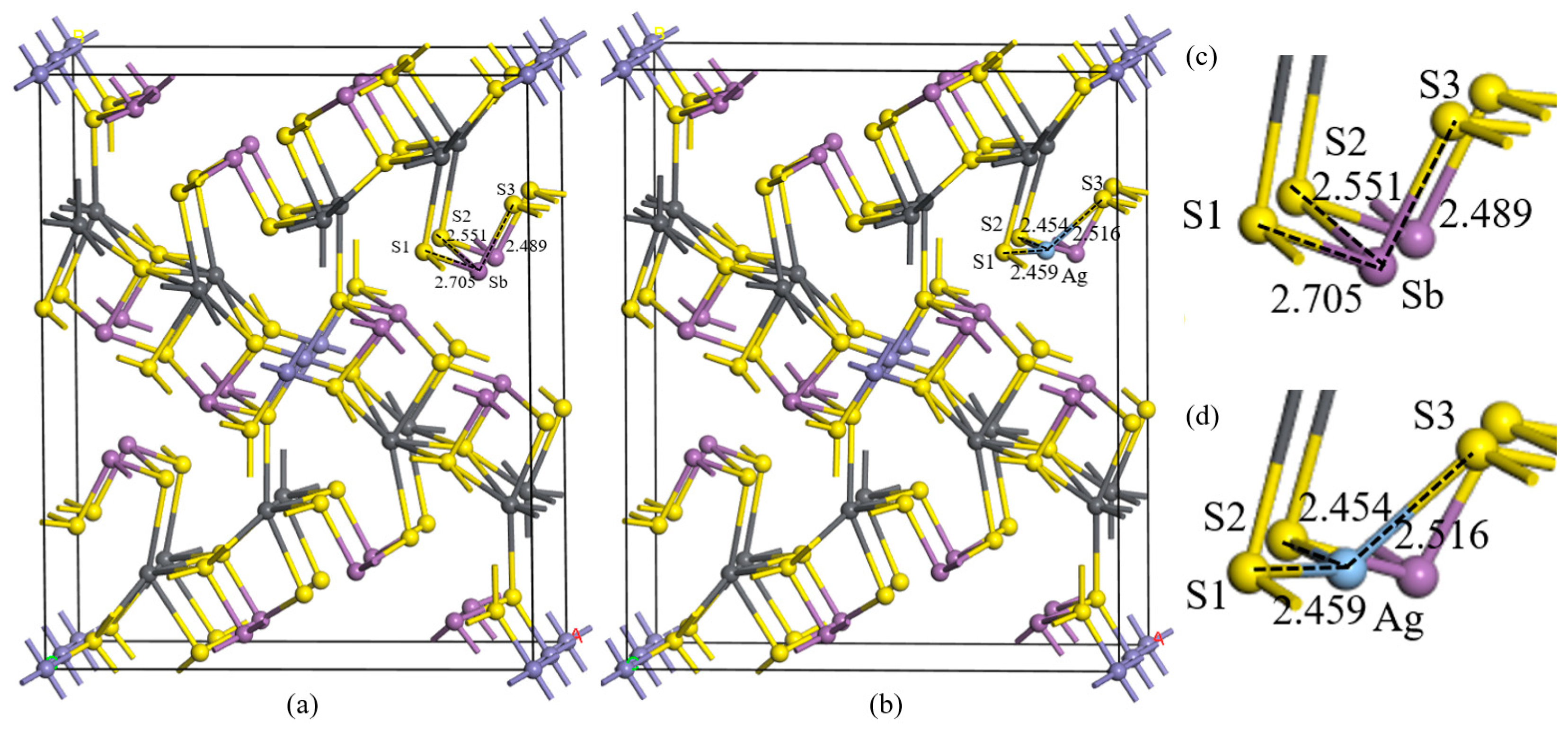
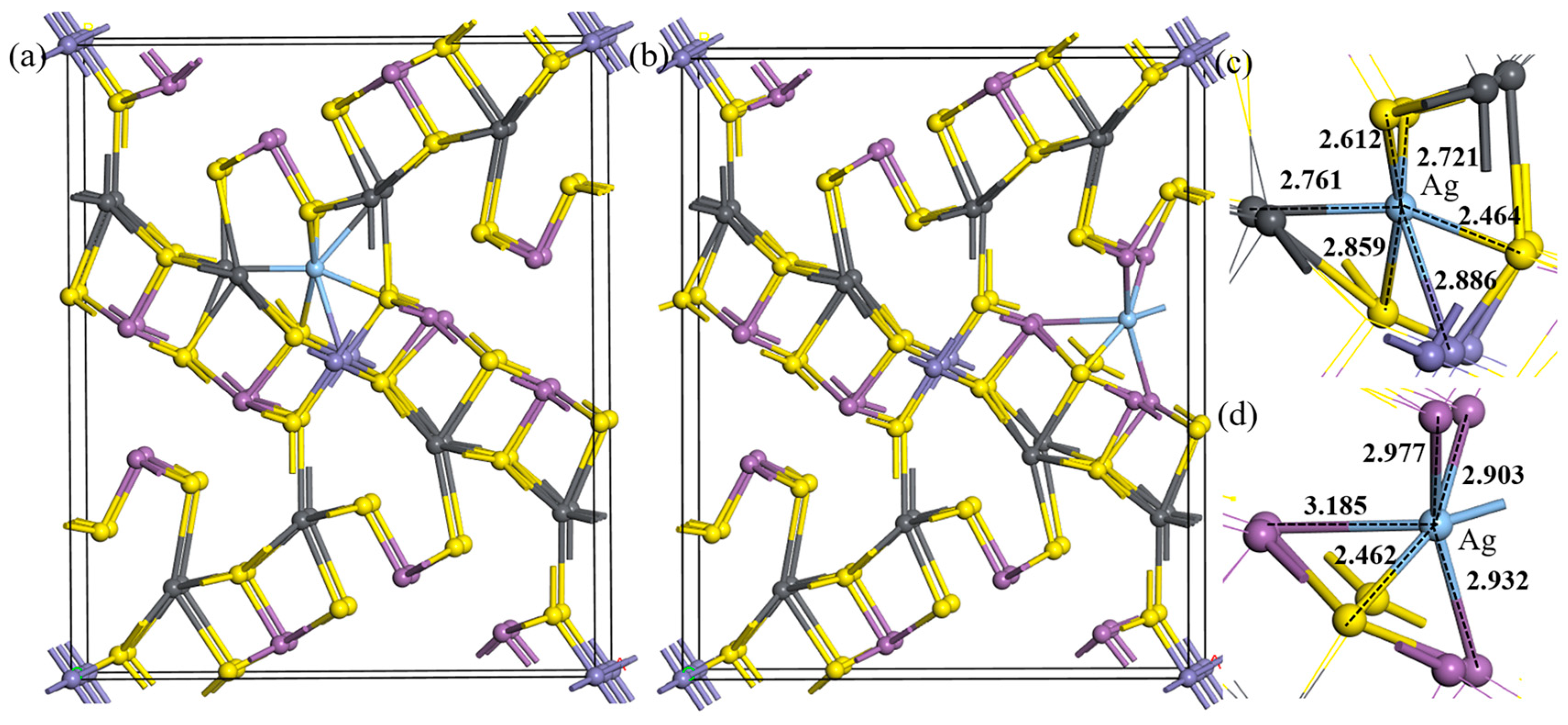
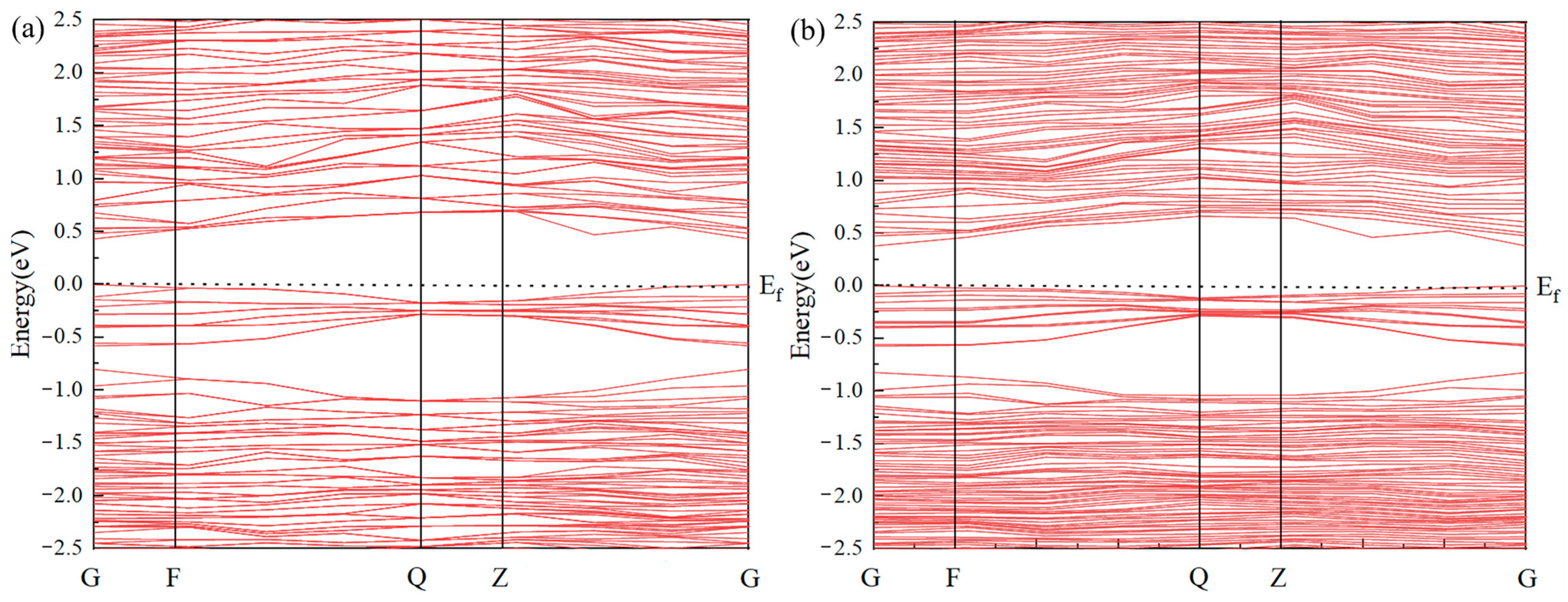
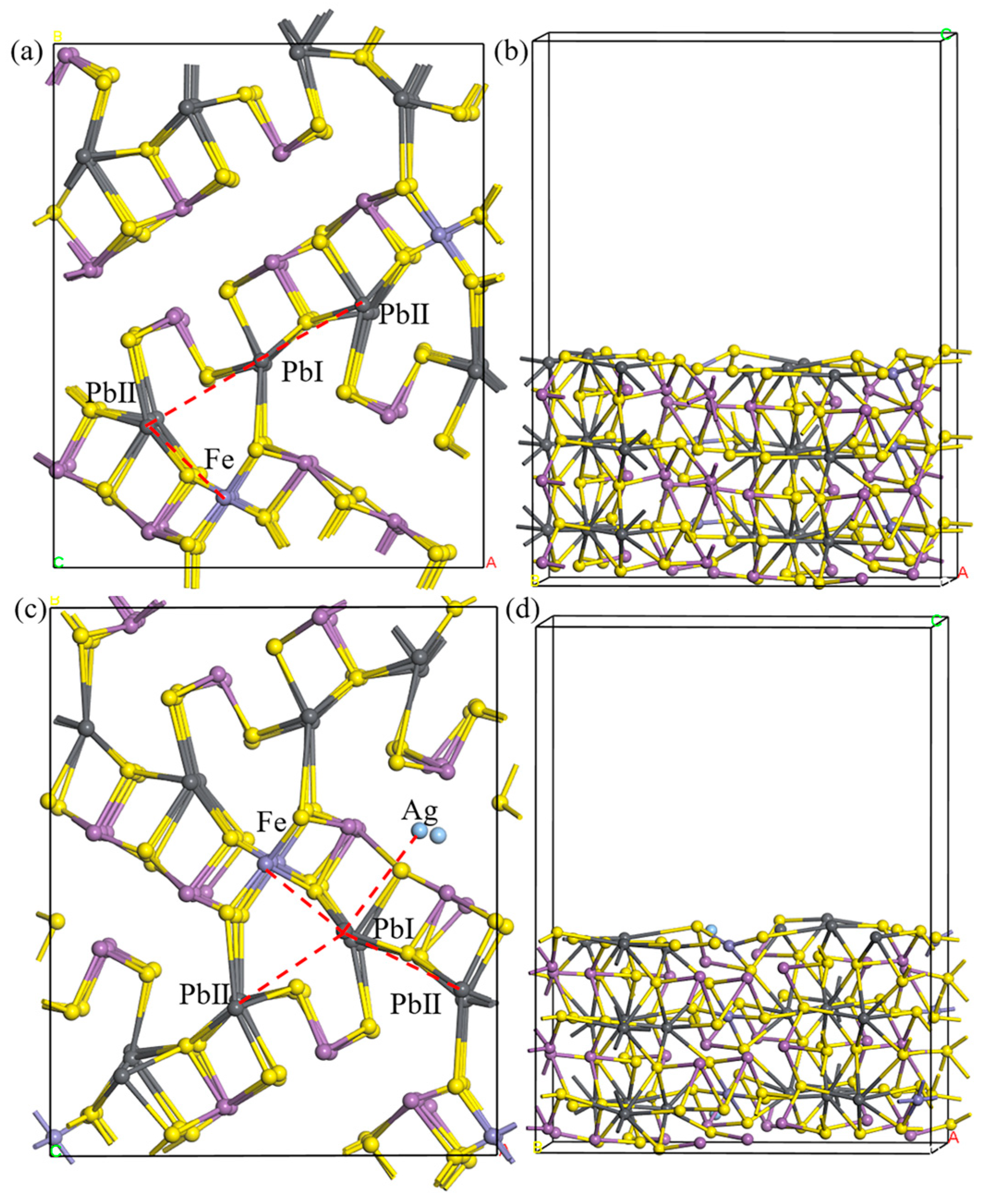
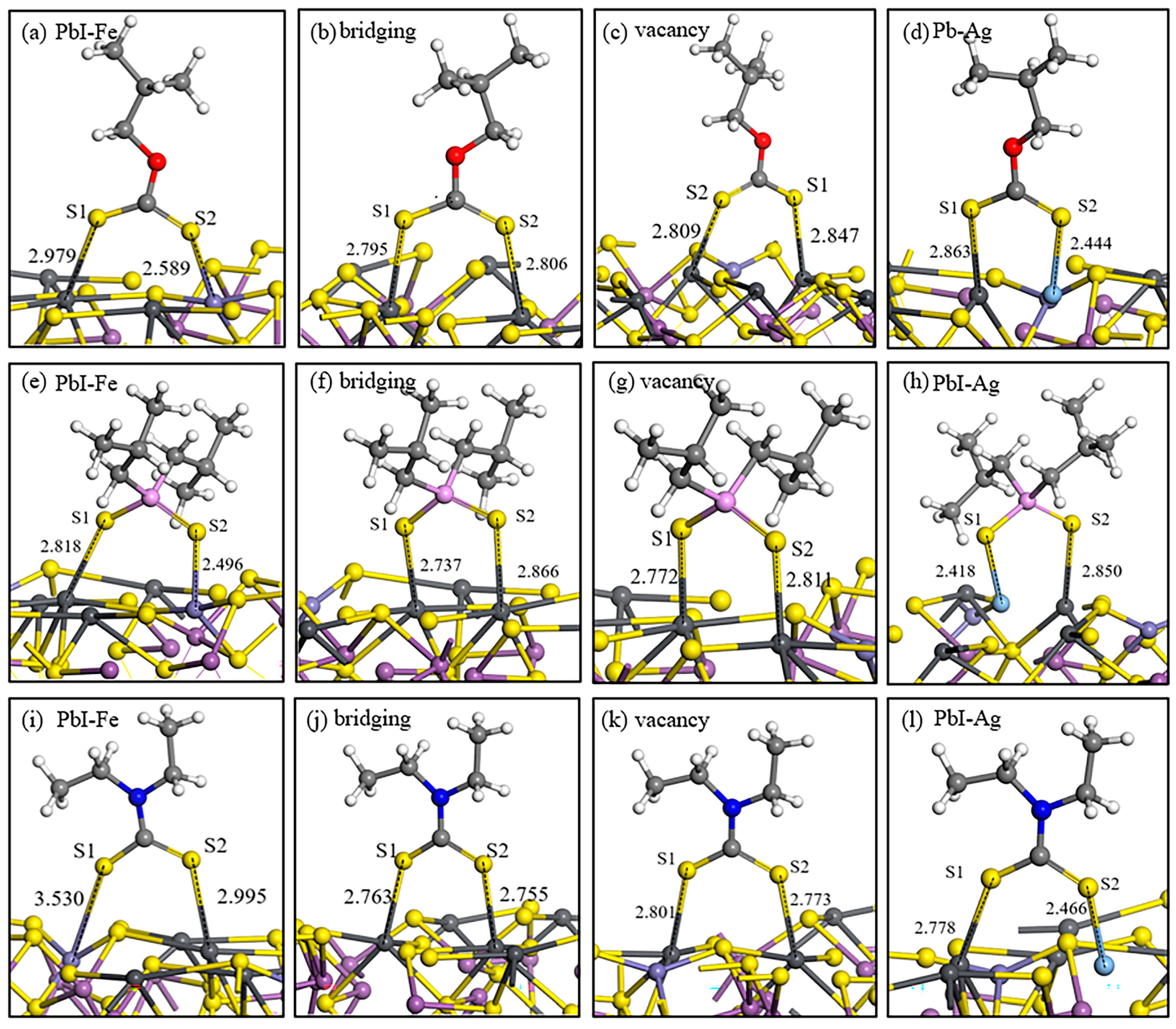
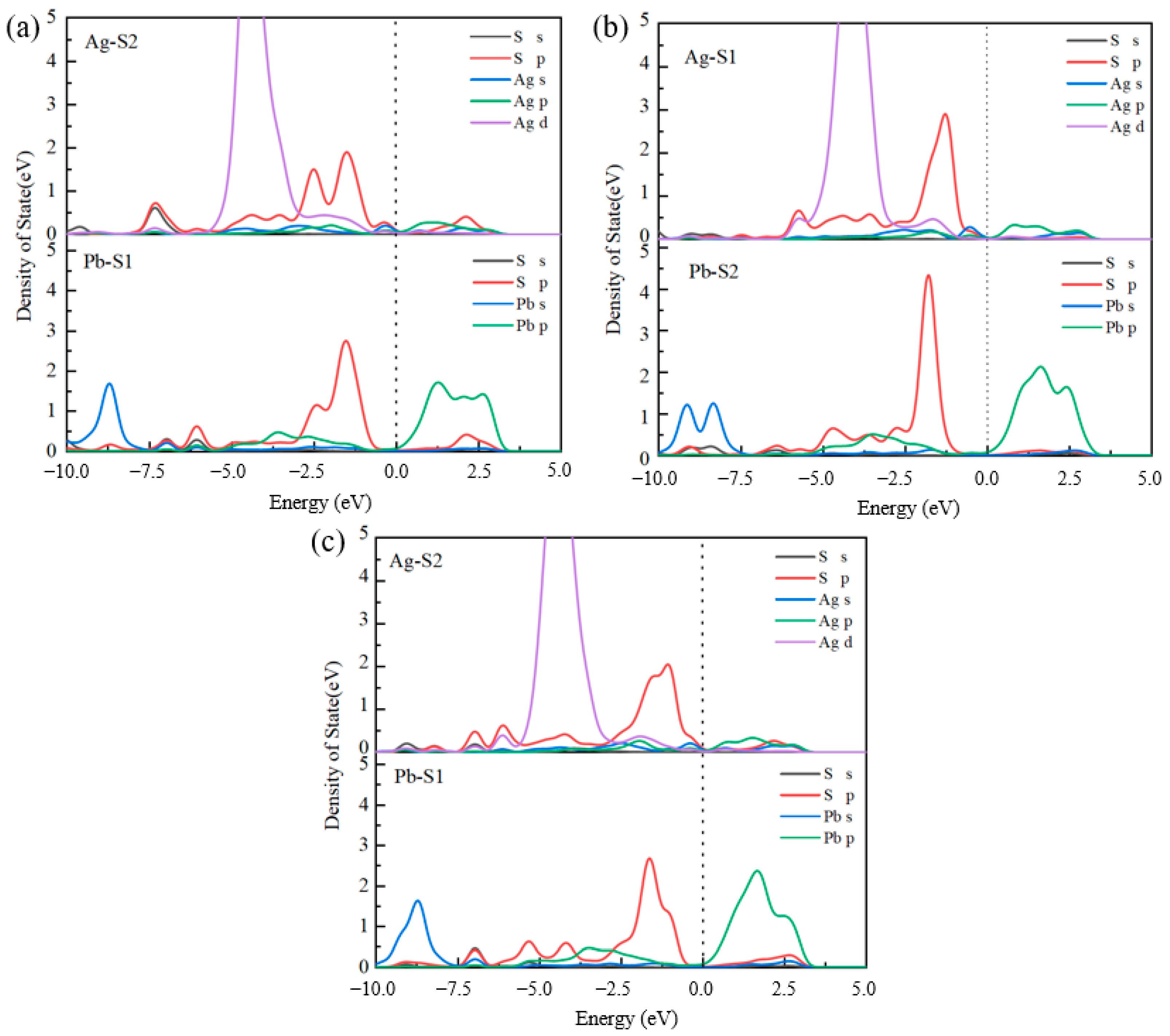



| Ore Type | Point Number | LA-ICP-MS Analysis of Trace Elements (ωB/10−6) | ||||||||
|---|---|---|---|---|---|---|---|---|---|---|
| Mn | Cu | Zn | As | Ag | Ba | In | Sn | Zr | ||
| Jamesonite | JMT–1 | 526.45 | 8.09 | 124.71 | 381.66 | 6.74 | 2.2 | 288.66 | 1420.82 | 0.11 |
| JMT–2 | 342.78 | 8.99 | 714.47 | 121.59 | 29.28 | 12.12 | 264.69 | 518.25 | 0.03 | |
| JMT–3 | 794.77 | 3.58 | 256.46 | 101.96 | 5.56 | 1.12 | 197.52 | 934.67 | – | |
| JMT–4 | 612.97 | 64.09 | 152.46 | 196.15 | 4.55 | 2.76 | 212.01 | 1726.19 | 286 | |
| JMT–5 | 1104.14 | 1.22 | 79.33 | 711.26 | 10.93 | 0.88 | 227.87 | 2402.91 | 0.1 | |
| JMT–6 | 953.93 | 35.44 | 5146.24 | 458.63 | 22.6 | 10.27 | 215.05 | 2063.65 | – | |
| JMT–7 | 1213.55 | 187.02 | 4867.8 | 262.53 | 144.71 | 20.63 | 187.65 | 1616.08 | 0.82 | |
| JMT–8 | 1115.27 | 2.86 | 85.99 | 105.47 | 10.19 | 4.56 | 240.39 | 829.12 | 0 | |
| JMT–9 | 1011.65 | 50.69 | 177.44 | 246.31 | 601.27 | 2.03 | 171.65 | 3349.72 | 102.62 | |
| JMT–10 | 859.24 | 9.91 | 97.91 | 418.89 | 91.28 | 1.82 | 182.64 | 1787.08 | – | |
| JMT–11 | 1092.1 | 123.15 | 39.28 | 864.28 | 22.74 | 1.14 | 230.47 | 5674.65 | – | |
| JMT–12 | 1093.55 | 5.92 | 1255.23 | 244.76 | 10.71 | 7.37 | 287.61 | 755.81 | 14.5 | |
| JMT–13 | 154.73 | 1.37 | 109.61 | 186.51 | 2.82 | 7.75 | 194.15 | 803.87 | 0 | |
| JMT–14 | 1121.33 | 9.16 | 373.84 | 791.03 | 211.87 | 2.26 | 138.37 | 4418.73 | – | |
| JMT–15 | 1163.45 | 0.48 | 0 | 35.19 | 10.15 | 0.93 | 347.68 | 539.97 | 0.07 | |
| JMT–16 | 877.33 | 34.13 | 898.72 | 341.75 | 79.03 | 5.19 | 225.76 | 1922.77 | 26.95 | |
| Substitution Type | a | b | c | α | β | γ | Formation Energy/(eV) |
|---|---|---|---|---|---|---|---|
| Jamesonite | 15.88 | 19.36 | 7.92 | 90.00 | 92.27 | 90.00 | 0 |
| 2–coordinate S | 16.06 | 19.74 | 7.93 | 89.66 | 91.59 | 89.75 | 2.17 |
| 3–coordinate S | 16.04 | 19.81 | 8.05 | 89.94 | 92.40 | 90.15 | 2.98 |
| 4–coordinate S | 15.92 | 19.33 | 7.96 | 90.08 | 91.74 | 90.00 | 2.02 |
| 5–coordinate S | 16.09 | 19.73 | 7.84 | 89.79 | 92.09 | 89.91 | 2.51 |
| 4–coordinate Fe | 15.96 | 19.79 | 8.07 | 90.16 | 92.59 | 89.94 | 2.33 |
| 6–coordinate Pb | 15.89 | 19.36 | 7.90 | 89.92 | 92.34 | 90.24 | 1.64 |
| 4–coordinate Sb | 15.90 | 19.35 | 7.92 | 90.15 | 92.30 | 90.12 | 1.16 |
| 3–coordinate Sb | 15.92 | 19.40 | 7.95 | 90.06 | 92.18 | 89.99 | 0.83 |
| Doping Form | a | b | c | α | β | γ | Formation Energy/(eV) |
|---|---|---|---|---|---|---|---|
| Jamesonite | 15.88 | 19.36 | 7.92 | 90.00 | 92.27 | 90.00 | 0 |
| S–Pb vacancy doping | 16.028 | 19.348 | 7.961 | 90.130 | 92.101 | 90.013 | −0.668 |
| S–Sb vacancy doping | 15.923 | 19.534 | 7.980 | 90.011 | 92.355 | 89.865 | −1.158 |
| Bond | Population | Length (Å) |
|---|---|---|
| S 29–Ag 1 | 0.41 | 2.46 |
| S 20–Ag 1 | 0.40 | 2.51 |
| Ag 1–Sb 7 | 0.00 | 2.90 |
| Ag 1–Sb 2 | −0.03 | 2.93 |
| Ag 1–Sb 19 | −0.06 | 2.98 |
| Mineral Type | Reagent | Adsorption Site | Adsorption Energy (kJ/mol) | M–S1 (Å) | M–S2 (Å) |
|---|---|---|---|---|---|
| Jamesonite | Butyl xanthate | PbI–Fe | −114.89 | 2.589 | 2.979 |
| PbI–PbII bridging | −161.98 | 2.795 | 2.806 | ||
| PbI–PbII vacancy | −156.32 | 2.847 | 2.809 | ||
| 3418A | PbI–Fe | −119.33 | 2.818 | 2.496 | |
| PbI–PbII bridging | −208.91 | 2.737 | 2.866 | ||
| PbI–PbII vacancy | −232.37 | 2.772 | 2.811 | ||
| DDTC | PbI–Fe | −174.59 | 3.53 | 2.995 | |
| PbI–PbII bridging | −242.97 | 2.801 | 2.773 | ||
| PbI–PbII vacancy | −253.98 | 2.763 | 2.755 | ||
| Ag-doped jamesonite | Butyl xanthate | Pb–Ag | −211.06 | 2.863 | 2.444 |
| 3418A | Pb–Ag | −241.42 | 2.85 | 2.418 | |
| DDTC | Pb–Ag | −256.67 | 2.778 | 2.466 |
| Reagent | Adsorption State | Mulliken Charge (e) | |||
|---|---|---|---|---|---|
| S1 | S2 | Ag | Pb | ||
| Butyl xanthate | Before | 0.00 | −0.1 | −0.1 | 0.54 |
| After | −0.14 | −0.12 | −0.05 | 0.52 | |
| 3418A | Before | −0.4 | −0.37 | −0.1 | 0.54 |
| After | −0.55 | −0.51 | −0.08 | 0.6 | |
| DDTC | Before | 0.03 | −0.02 | −0.1 | 0.54 |
| After | −0.23 | −0.15 | −0.06 | 0.67 | |
| Cutoff | Energy/(eV) | Lattice/(Å) | |||
|---|---|---|---|---|---|
| a | b | c | β | ||
| 250 | −24,641.30 | 16.23 | 19.52 | 4.11 | 92.10 |
| 280 | −24,641.24 | 15.91 | 19.91 | 3.94 | 92.59 |
| 310 | −24,641.74 | 15.84 | 19.32 | 3.95 | 92.23 |
| 340 | −24,642.09 | 15.89 | 19.36 | 3.96 | 92.27 |
| 370 | −24,641.75 | 15.85 | 19.62 | 3.93 | 91.77 |
| 400 | −24,641.85 | 16.06 | 19.59 | 3.93 | 91.83 |
| 430 | −24,641.5 | 15.82 | 19.42 | 3.91 | 91.58 |
Disclaimer/Publisher’s Note: The statements, opinions and data contained in all publications are solely those of the individual author(s) and contributor(s) and not of MDPI and/or the editor(s). MDPI and/or the editor(s) disclaim responsibility for any injury to people or property resulting from any ideas, methods, instructions or products referred to in the content. |
© 2025 by the authors. Licensee MDPI, Basel, Switzerland. This article is an open access article distributed under the terms and conditions of the Creative Commons Attribution (CC BY) license (https://creativecommons.org/licenses/by/4.0/).
Share and Cite
Chen, H.; Yang, X.; Li, Y.; Chen, J. A Density Functional Theory Study on the Effects of Silver Doping on the Properties and Flotation Behavior of Jamesonite. Molecules 2025, 30, 1424. https://doi.org/10.3390/molecules30071424
Chen H, Yang X, Li Y, Chen J. A Density Functional Theory Study on the Effects of Silver Doping on the Properties and Flotation Behavior of Jamesonite. Molecules. 2025; 30(7):1424. https://doi.org/10.3390/molecules30071424
Chicago/Turabian StyleChen, Huimin, Xi Yang, Yuqiong Li, and Jianhua Chen. 2025. "A Density Functional Theory Study on the Effects of Silver Doping on the Properties and Flotation Behavior of Jamesonite" Molecules 30, no. 7: 1424. https://doi.org/10.3390/molecules30071424
APA StyleChen, H., Yang, X., Li, Y., & Chen, J. (2025). A Density Functional Theory Study on the Effects of Silver Doping on the Properties and Flotation Behavior of Jamesonite. Molecules, 30(7), 1424. https://doi.org/10.3390/molecules30071424





